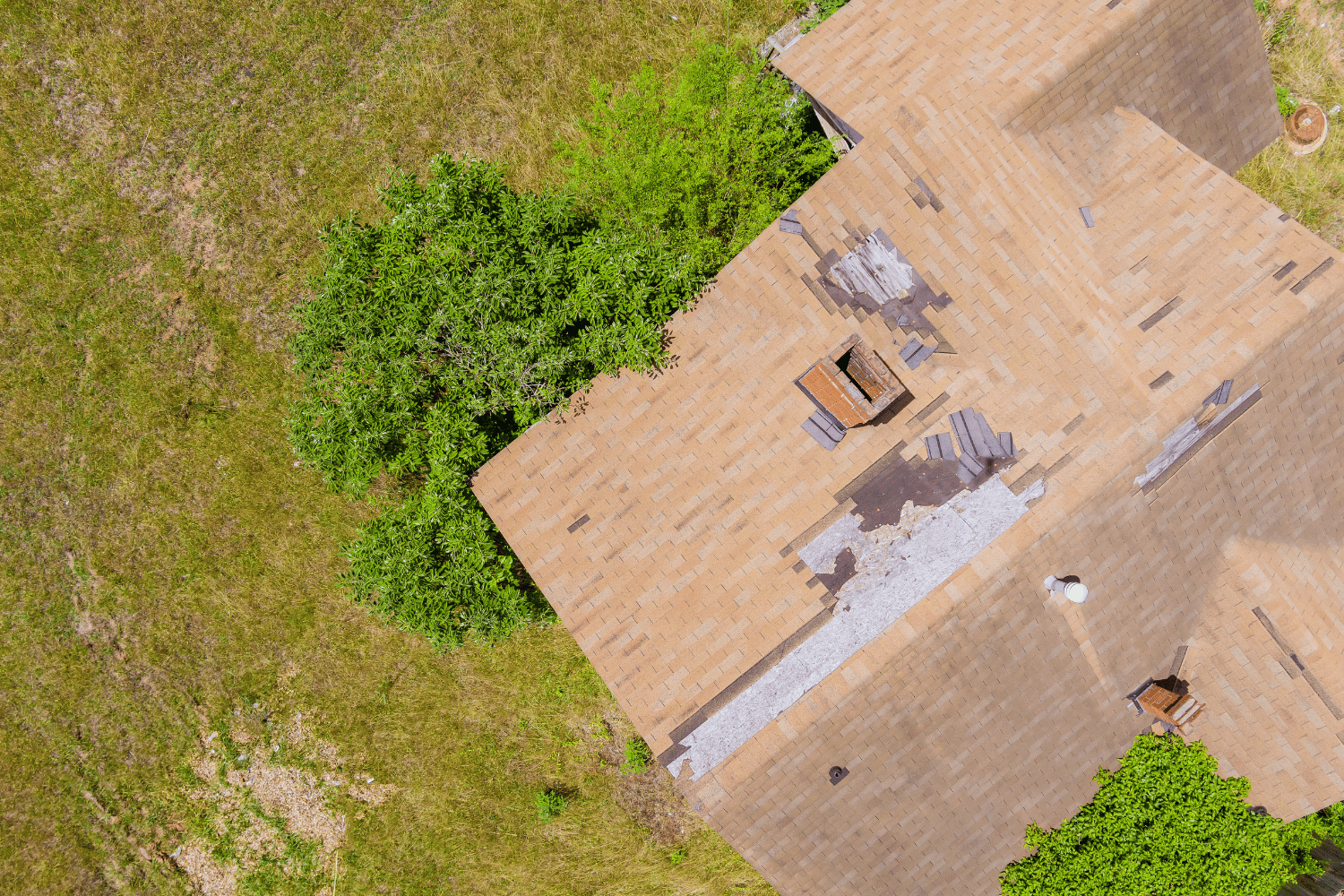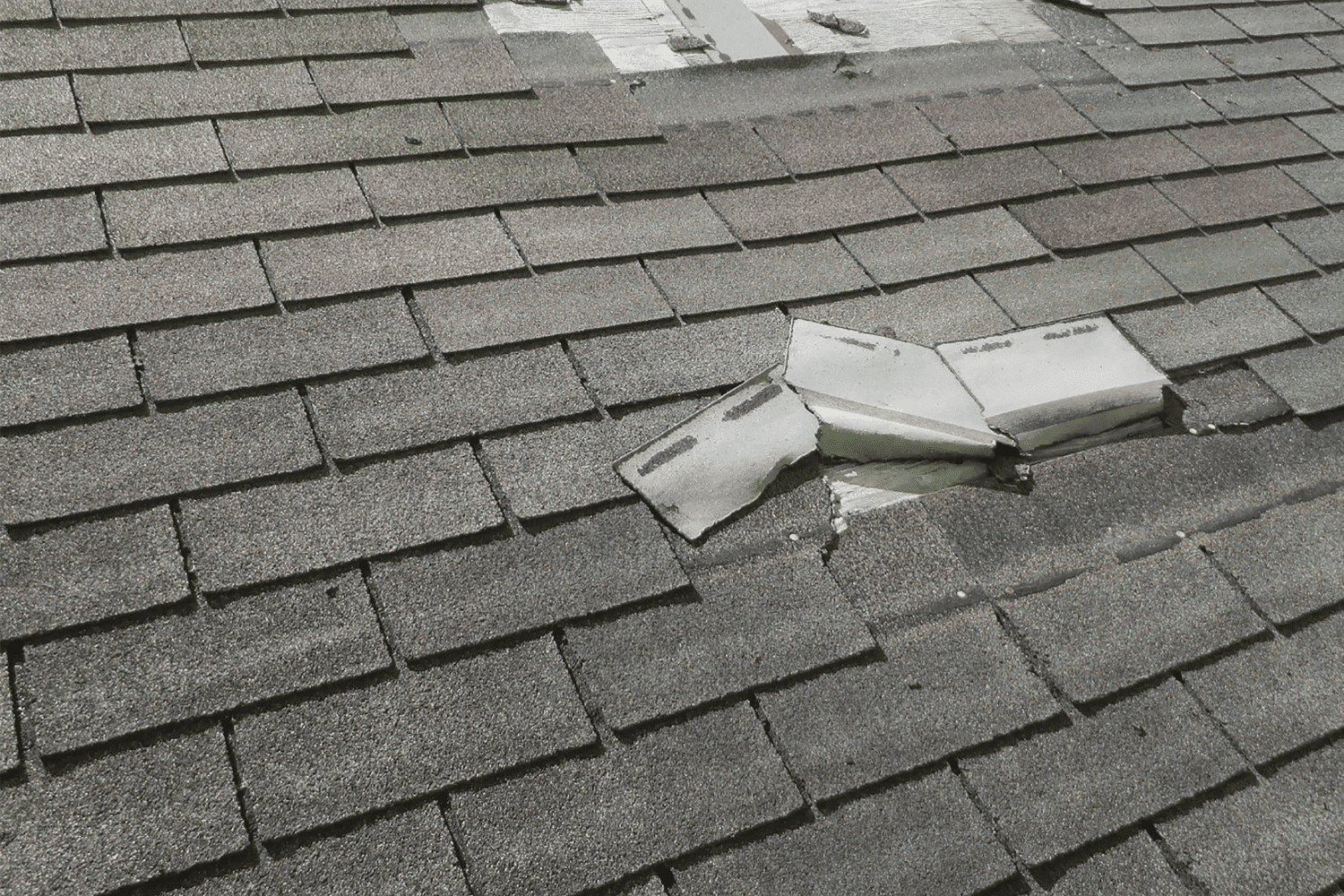Top Tips for Identifying Wind Shingle Damage on Your Roof
Worried about wind shingle damage after a storm? This guide helps you spot signs of damage and shows you the next steps for repairs.
Key Takeaways
-
Early detection of wind shingle damage, such as loose, missing, or creased shingles, is crucial to prevent more extensive repairs and maintain roof integrity.
-
Post-storm inspections of the roof, gutters, and attic are essential for identifying potential wind damage and leaks, ensuring timely intervention.
-
Proactive measures, including installing wind-resistant shingles and conducting regular maintenance, are vital in reducing the risk of future wind damage to the roof.
Recognizing Wind Shingle Damage

Spotting the early signs of wind shingle damage can be the difference between a minor repair and a major overhaul. Wind damage on roofs often occurs due to strong winds that can lift and blow roofing materials off. Homeowners should be vigilant for common signs such as loose shingles, missing shingles, and creased shingles. Recognizing these signs early allows for timely repairs, preventing leaks and structural problems.
After a storm, it’s crucial to inspect your roof for damage. Wind speeds of 50 to 60 mph can start to pose a risk to shingle roofs, compromising their integrity. Let’s delve deeper into the specific types of damage to look for, starting with loose or curling shingles.
Loose or Curling Shingles
Lifted or curled shingles are significant indicators of wind-related damage that homeowners should look for. Curling shingles may suggest that a roof is aging. They can also be a sign of improper installation. Common signs include raised shingles and creased tabs. These issues increase susceptibility to leaks, posing risks to the roof’s integrity. Consult a roofing professional if you notice lifting on your shingles.
Routine inspections can catch minor issues before they become significant problems. Upturned edges of shingles often indicate curling, potentially leading to further damage. Sealing seams and edges helps prevent wind from lifting shingles. Promptly addressing these issues can prevent more severe damage to your roof.
Missing Shingles
Strong winds can tear shingles off your roof. This exposes the roof deck, creating gaps. Missing shingles clearly indicate wind damage. Check for cracked, curled, sagging, or misaligned shingles as indicators of loose or damaged shingles. Shingles in your yard after a storm straightforwardly indicate roof wind damage.
Missing shingles compromise the roof’s water resistance, leading to potential leaks. Enlist a local roofing professional if you find missing shingles. Document damage, as missing or lifted shingles are often covered by homeowners’ insurance.
Creased Shingles
Wind pressure can cause tearing, warping, and vertical folding of shingles. Wind uplift pressure primarily causes creased shingles. Darker lines on creased shingles signify wind pressure damage. This damage compromises the roof’s integrity over time, increasing susceptibility to leaks and other issues.
Creased shingles pose a significant risk to the roof’s structural integrity. Regular inspections and prompt repairs prevent these issues from worsening. Staying vigilant and addressing creased shingles promptly maintains your roof’s health and longevity.
Inspecting Your Roof for Wind Damage

Conduct a thorough roof inspection after a storm. Strong storms often reveal wind damage, necessitating comprehensive inspections. Check your roof for dents, missing or cracked shingles, or fallen debris. Routine inspections identify potential issues before they escalate.
Shingle wind damage can be subtle, requiring close inspection to identify. Checking the roof exterior, gutters, downspouts, and the attic and interior are essential inspection steps. Let’s explore each of these areas in detail to ensure no damage goes unnoticed.
Checking the Roof Exterior
Visually inspect your roof and the ground around your property for damage after storms. Binoculars can help spot lifted shingles or minor damage from the ground during your inspection. Clear signs of roof wind damage include twisted shingles, missing shingles in the yard, and shingles flapping in the wind.
Debris accumulation on the roof can cause drainage problems and indicate underlying damage. Regular inspections identify potential roof issues before they worsen. Addressing early signs can prevent more severe damage.
Examining Gutters and Downspouts
High winds can cause granule loss from asphalt shingles. This loss often leads to granule accumulation in gutters. Checking for accumulated granules in gutters and downspouts is essential for roof inspection. Granule buildup in gutters indicates potential shingle damage requiring replacement.
Granule accumulation in gutters often points to wind-caused shingle deterioration. Regularly examining gutters and downspouts helps identify these issues early, allowing for necessary action to maintain roof health.
Inspecting the Attic and Interior
Interior water stains primarily indicate wind damage has caused roof leaks. Regularly check your interior for roof leaks in the aftermath of strong winds. Inspecting the attic and interior can reveal leaks and hidden damage.
Identifying these issues early prevents further damage, ensuring your roof remains in good condition. Regular attic and interior inspections are crucial for maintaining overall roof and home health.
What to Do if You Suspect Wind Damage

Prompt action is essential if you suspect wind damage to your roof. Immediately document any visible roof damage with photos and notes to support insurance claims. Documentation is crucial for insurance claims and repair estimates.
Consult a reputable professional roofer for a thorough inspection and repair plan. Delaying repairs can worsen damage and leaks.
Here are the steps to take if you suspect wind damage, starting with documentation.
Documenting the Damage
Document all visible damage for insurance claims and repair estimates. Taking pictures provides evidence needed for insurance claims. Thorough records and documentation aid in obtaining accurate repair estimates.
Meticulous documentation ensures you have all the necessary information to support your insurance claim and obtain the best repair estimate. This step is crucial after a storm.
Contacting a Professional Roofer
Promptly addressing impact-damaged shingles and roof shingles is crucial. This helps prevent water intrusion and rapid deterioration. Contact a professional roofer if you suspect roof damage after a windstorm. Achieve peace of mind by asking for references and proof of insurance when hiring a roofing contractor.
An experienced roofing contractor ensures thorough inspection and accurate repairs. After documenting shingle damage, getting a repair estimate and inspection from a local roofer is crucial. A reputable roofing contractor ensures correct assessment and repairs.
Filing an Insurance Claim
Familiarize yourself with your policy coverage for wind damage before filing a claim. Most homeowner insurance policies cover roof wind damage, including hail damage and acts of God. Coverage for shingle damage varies based on policy specifics. Local regulations may also influence coverage.
File a claim with your insurance provider if the damage is severe. The insurance company will send an adjuster to assess the damage. Remember, insurance companies might lowball the repair estimate.
Document damage before filing an insurance claim to help the adjuster determine repair costs. Have a professional roofer inspect the damage in addition to your documentation for the insurance claim.
Preventing Future Wind Damage

Proactive measures are required to prevent future wind damage. Secure shingles with nails and caulk to prevent wind uplift during storms. Using longer nails (1-1/2” to 2”) enhances shingle security against wind. Trimming tree branches around your home reduces the risk of roof damage from falling debris.
Consider installing storm shutters to protect against severe wind conditions. Ridge vents help maintain roof pressure, reducing wind damage risk.
Here are specific strategies to prevent future wind damage, starting with installing wind-resistant shingles.
Installing Wind-Resistant Shingles
High-quality wind-resistant asphalt roof shingles enhance your roof’s durability against strong winds. Proper installation techniques, like correct nailing and adequate overlap, maximize wind resistance. Reinforce the roof structure with hurricane straps and secure the roof decking to significantly improve wind resilience.
Regular maintenance, including inspections and repairs, identifies and mitigates potential wind damage vulnerabilities before they worsen. Investing in wind-resistant shingles and proper installation fortifies your roof against future wind events.
Regular Roof Maintenance
Removing roof debris prevents water accumulation that can damage shingles. Maintaining shingles and replacing damaged ones reduces the risk of wind-related damage. Regular maintenance keeps your roof in top condition.
Regular roof inspections and prompt addressing of minor issues prevent severe damage and ensure wind resilience. Regular maintenance is key to long-term roof health.
Reinforcing Roof Structure
Hurricane straps significantly strengthen a roof’s resistance to high winds. Hurricane straps and clips significantly enhance a roof’s wind resistance. Metal straps, or hurricane ties, secure roofs against high winds.
Reinforcing the roof decking enhances structural integrity, allowing it to withstand stronger gusts. Truss bracing provides additional support, enhancing the roof’s wind resistance. Reinforcing the roof structure significantly improves its wind resistance.
Summary
In conclusion, recognizing and addressing wind shingle damage promptly is crucial for maintaining the integrity of your roof. Regular inspections, proper documentation, and consulting professional roofers are essential steps in managing wind damage. By taking proactive measures such as installing wind-resistant shingles and reinforcing the roof structure, homeowners can protect their roofs from future wind events.
Remember, the key to a resilient roof lies in regular maintenance and timely repairs. Stay vigilant, and your roof will continue to provide the protection your home needs against the elements.
Frequently Asked Questions
How can I tell if my roof has wind damage?
You can determine if your roof has wind damage by inspecting for loose, curling, missing, or creased shingles, as well as checking for granules in the gutters and water stains in the attic or interior. If you notice any of these signs, it is advisable to seek professional assessment.
What should I do if I find wind damage on my roof?
If you find wind damage on your roof, promptly document the damage with photographs, consult a professional roofer for an inspection, and consider filing an insurance claim if appropriate. Taking these steps ensures your roof is assessed and repaired effectively.
How can I prevent wind damage to my roof in the future?
To prevent wind damage to your roof in the future, it is essential to install wind-resistant shingles, conduct regular maintenance, and reinforce the roof structure with hurricane straps and truss bracing. Taking these steps will significantly enhance your roof’s resilience against high winds.
Does homeowners’ insurance cover wind damage?
Homeowners’ insurance typically covers wind damage, including hail, although coverage specifics may vary by policy. It is essential to review your individual policy details to understand the extent of your coverage.
How often should I inspect my roof for wind damage?
It is advisable to inspect your roof for wind damage regularly, particularly after storms with high winds, to identify and address any potential issues promptly.






